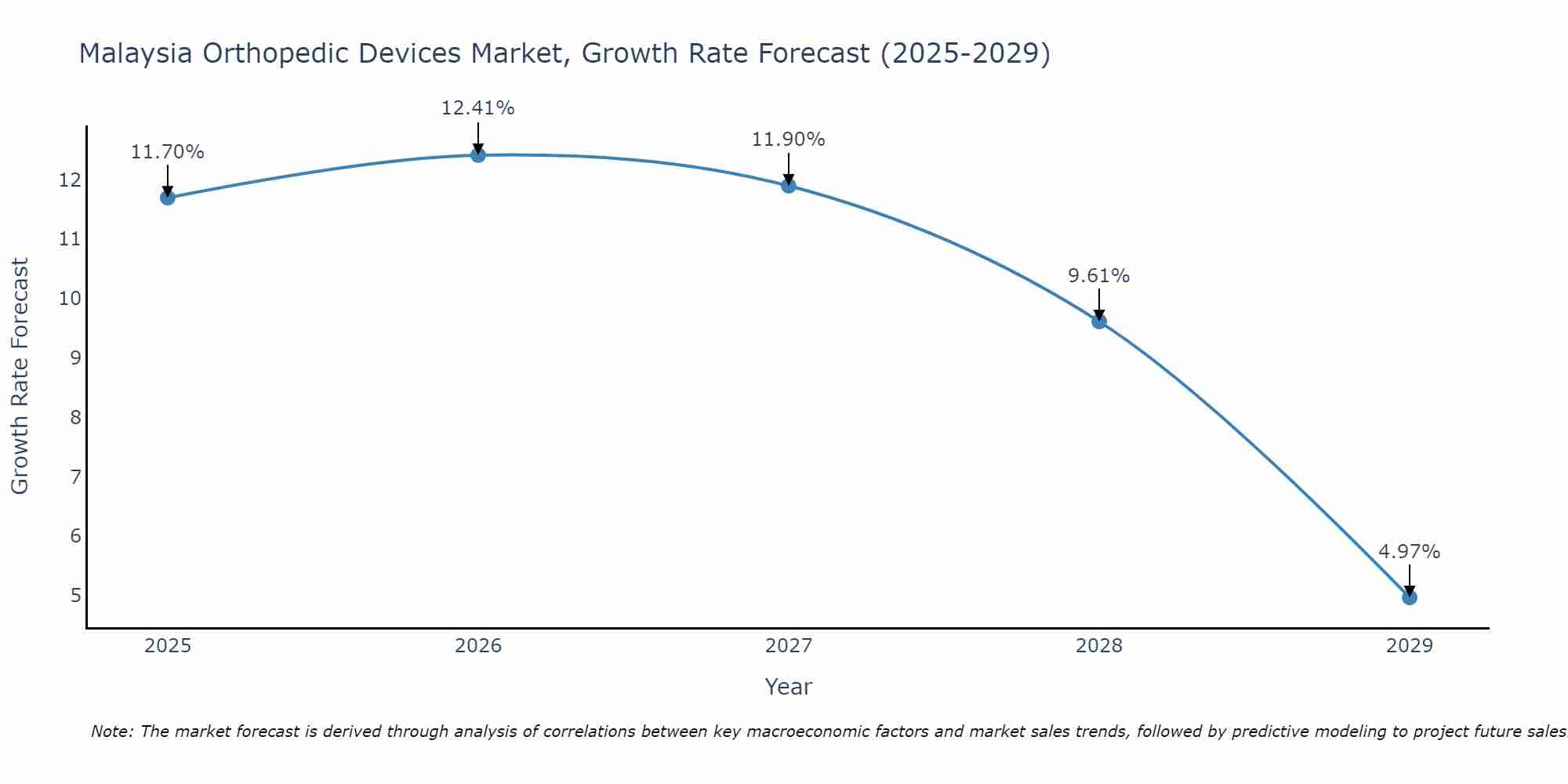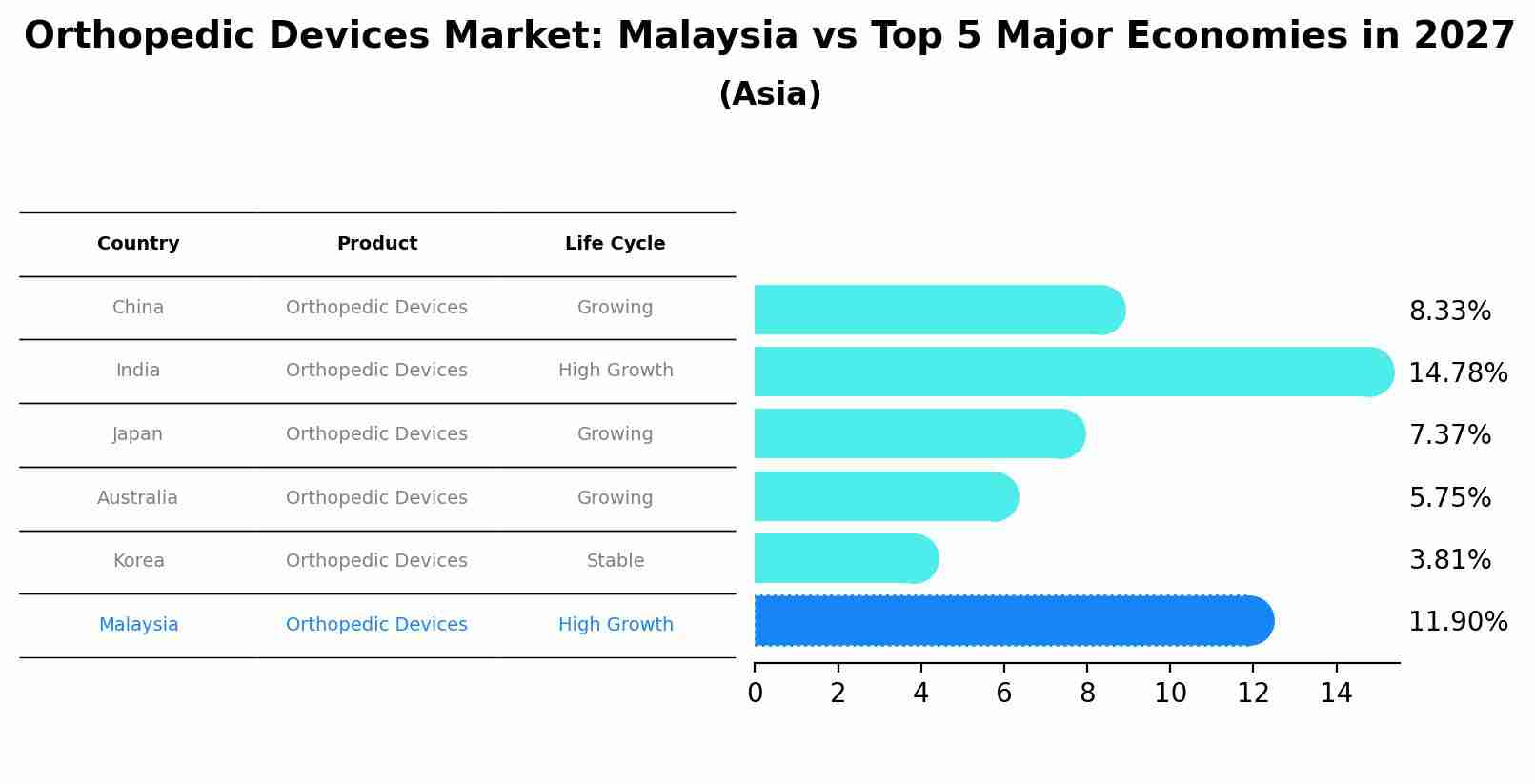Malaysia Orthopedic Devices Market (2025-2031) Outlook | Revenue, Size, Analysis, Industry, Value, Companies, Share, Trends, Growth & Forecast
| Product Code: ETC368126 | Publication Date: Aug 2022 | Updated Date: Apr 2025 | Product Type: Market Research Report | |
| Publisher: 6Wresearch | No. of Pages: 75 | No. of Figures: 35 | No. of Tables: 20 | |
Malaysia Orthopedic Devices Market Size Growth Rate
The Malaysia Orthopedic Devices Market is projected to witness mixed growth rate patterns during 2025 to 2029. The growth rate begins at 11.70% in 2025, climbs to a high of 12.41% in 2026, and moderates to 4.97% by 2029.

Orthopedic Devices Market: Malaysia vs Top 5 Major Economies in 2027 (Asia)
By 2027, the Orthopedic Devices market in Malaysia is anticipated to reach a growth rate of 11.90%, as part of an increasingly competitive Asia region, where China remains at the forefront, supported by India, Japan, Australia and South Korea, driving innovations and market adoption across sectors.

Malaysia Orthopedic Devices Market Synopsis
The orthopedic devices market in Malaysia is witnessing substantial growth, attributed to factors such as an aging population, increasing sports-related injuries, and advancements in orthopedic technologies. Joint replacement procedures and minimally invasive surgeries are gaining popularity, influencing the demand for orthopedic implants and instruments.
Drivers of the Market
The orthopedic devices market in Malaysia is experiencing robust growth, driven by several key factors. Firstly, an aging population and a rising incidence of orthopedic conditions, such as osteoarthritis and fractures, are fueling the demand for orthopedic devices. Additionally, an increasing awareness about the benefits of early intervention and advanced orthopedic treatments is driving market growth. Furthermore, technological advancements in materials and implant designs are leading to more durable and patient-specific orthopedic solutions. The adoption of minimally invasive surgical techniques is also contributing to the growth of the orthopedic devices market in Malaysia. Moreover, favorable government policies and initiatives aimed at improving healthcare infrastructure and accessibility are creating a conducive environment for market expansion.
Challenges of the Market
The Malaysia orthopedic devices market is experiencing growth due to an aging population and an increase in sports-related injuries. Joint replacement surgeries and orthopedic implants are in demand. Challenges include regulatory compliance and the high cost of orthopedic procedures.
COVID-19 Impact on the Market
The orthopedic devices market in Malaysia has experienced steady growth due to an aging population and a rising incidence of orthopedic conditions. The COVID-19 pandemic disrupted elective surgeries and reduced patient visits, impacting the market. However, as healthcare services resumed, the market started to recover. Technological advancements and increasing healthcare infrastructure will likely contribute to future market expansion.
Key Players in the Market
The orthopedic devices market in Malaysia is experiencing growth due to factors such as an aging population and the increasing incidence of orthopedic conditions. Key players like Stryker Corporation, Medtronic, and Zimmer Biomet offer a comprehensive range of orthopedic implants and instruments. These devices are crucial for joint replacement surgeries, fracture management, and orthopedic rehabilitation. The market is also witnessing innovation in materials and implant designs to enhance patient outcomes, contributing to its positive outlook.
Key Highlights of the Report:
- Malaysia Orthopedic Devices Market Outlook
- Market Size of Malaysia Orthopedic Devices Market, 2024
- Forecast of Malaysia Orthopedic Devices Market, 2031
- Historical Data and Forecast of Malaysia Orthopedic Devices Revenues & Volume for the Period 2021-2031
- Malaysia Orthopedic Devices Market Trend Evolution
- Malaysia Orthopedic Devices Market Drivers and Challenges
- Malaysia Orthopedic Devices Price Trends
- Malaysia Orthopedic Devices Porter's Five Forces
- Malaysia Orthopedic Devices Industry Life Cycle
- Historical Data and Forecast of Malaysia Orthopedic Devices Market Revenues & Volume By Application for the Period 2021-2031
- Historical Data and Forecast of Malaysia Orthopedic Devices Market Revenues & Volume By Hip Orthopedic Devices for the Period 2021-2031
- Historical Data and Forecast of Malaysia Orthopedic Devices Market Revenues & Volume By Knee Orthopedic Devices for the Period 2021-2031
- Historical Data and Forecast of Malaysia Orthopedic Devices Market Revenues & Volume By Spine Orthopedic Devices for the Period 2021-2031
- Historical Data and Forecast of Malaysia Orthopedic Devices Market Revenues & Volume By Craniomaxillofacial Orthopedic Devices for the Period 2021-2031
- Historical Data and Forecast of Malaysia Orthopedic Devices Market Revenues & Volume By Dental Orthopedic Devices for the Period 2021-2031
- Historical Data and Forecast of Malaysia Orthopedic Devices Market Revenues & Volume By Sports Injuries, Extremities And Trauma (Set) Orthopedic Devices for the Period 2021-2031
- Historical Data and Forecast of Malaysia Orthopedic Devices Market Revenues & Volume By Product for the Period 2021-2031
- Historical Data and Forecast of Malaysia Orthopedic Devices Market Revenues & Volume By Drill Guide for the Period 2021-2031
- Historical Data and Forecast of Malaysia Orthopedic Devices Market Revenues & Volume By Guide Tubes for the Period 2021-2031
- Historical Data and Forecast of Malaysia Orthopedic Devices Market Revenues & Volume By Implant Holder for the Period 2021-2031
- Historical Data and Forecast of Malaysia Orthopedic Devices Market Revenues & Volume By Custom Clamps for the Period 2021-2031
- Historical Data and Forecast of Malaysia Orthopedic Devices Market Revenues & Volume By Distracters for the Period 2021-2031
- Historical Data and Forecast of Malaysia Orthopedic Devices Market Revenues & Volume By Screw Drivers for the Period 2021-2031
- Historical Data and Forecast of Malaysia Orthopedic Devices Market Revenues & Volume By Accessories for the Period 2021-2031
- Malaysia Orthopedic Devices Import Export Trade Statistics
- Market Opportunity Assessment By Application
- Market Opportunity Assessment By Product
- Malaysia Orthopedic Devices Top Companies Market Share
- Malaysia Orthopedic Devices Competitive Benchmarking By Technical and Operational Parameters
- Malaysia Orthopedic Devices Company Profiles
- Malaysia Orthopedic Devices Key Strategic Recommendations
Frequently Asked Questions About the Market Study (FAQs):
- Single User License$ 1,995
- Department License$ 2,400
- Site License$ 3,120
- Global License$ 3,795
Search
Related Reports
- Vietnam System Integrator Market (2025-2031) | Size, Companies, Analysis, Industry, Value, Forecast, Growth, Trends, Revenue & Share
- ASEAN and Thailand Brain Health Supplements Market (2025-2031) | Strategy, Consumer Insights, Analysis, Investment Trends, Opportunities, Growth, Size, Share, Industry, Revenue, Segments, Value, Segmentation, Supply, Forecast, Restraints, Outlook, Competition, Drivers, Trends, Demand, Pricing Analysis, Competitive, Strategic Insights, Companies, Challenges
- ASEAN Bearings Market (2025-2031) | Strategy, Consumer Insights, Analysis, Investment Trends, Opportunities, Growth, Size, Share, Industry, Revenue, Segments, Value, Segmentation, Supply, Forecast, Restraints, Outlook, Competition, Drivers, Trends, Demand, Pricing Analysis, Competitive, Strategic Insights, Companies, Challenges
- Europe Flooring Market (2025-2031) | Outlook, Share, Industry, Trends, Forecast, Companies, Revenue, Size, Analysis, Growth & Value
- Saudi Arabia Manlift Market (2025-2031) | Outlook, Size, Growth, Trends, Companies, Industry, Revenue, Value, Share, Forecast & Analysis
- Uganda Excavator, Crane, and Wheel Loaders Market (2025-2031) | Strategy, Consumer Insights, Analysis, Investment Trends, Opportunities, Growth, Size, Share, Industry, Revenue, Segments, Value, Segmentation, Supply, Forecast, Restraints, Outlook, Competition, Drivers, Trends, Demand, Pricing Analysis, Competitive, Strategic Insights, Companies, Challenges
- Rwanda Excavator, Crane, and Wheel Loaders Market (2025-2031) | Strategy, Consumer Insights, Analysis, Investment Trends, Opportunities, Growth, Size, Share, Industry, Revenue, Segments, Value, Segmentation, Supply, Forecast, Restraints, Outlook, Competition, Drivers, Trends, Demand, Pricing Analysis, Competitive, Strategic Insights, Companies, Challenges
- Kenya Excavator, Crane, and Wheel Loaders Market (2025-2031) | Strategy, Consumer Insights, Analysis, Investment Trends, Opportunities, Growth, Size, Share, Industry, Revenue, Segments, Value, Segmentation, Supply, Forecast, Restraints, Outlook, Competition, Drivers, Trends, Demand, Pricing Analysis, Competitive, Strategic Insights, Companies, Challenges
- Angola Excavator, Crane, and Wheel Loaders Market (2025-2031) | Strategy, Consumer Insights, Analysis, Investment Trends, Opportunities, Growth, Size, Share, Industry, Revenue, Segments, Value, Segmentation, Supply, Forecast, Restraints, Outlook, Competition, Drivers, Trends, Demand, Pricing Analysis, Competitive, Strategic Insights, Companies, Challenges
- Israel Intelligent Transport System Market (2025-2031) | Strategy, Consumer Insights, Analysis, Investment Trends, Opportunities, Growth, Size, Share, Industry, Revenue, Segments, Value, Segmentation, Supply, Forecast, Restraints, Outlook, Competition, Drivers, Trends, Demand, Pricing Analysis, Competitive, Strategic Insights, Companies, Challenges
Industry Events and Analyst Meet
Our Clients
Whitepaper
- Middle East & Africa Commercial Security Market Click here to view more.
- Middle East & Africa Fire Safety Systems & Equipment Market Click here to view more.
- GCC Drone Market Click here to view more.
- Middle East Lighting Fixture Market Click here to view more.
- GCC Physical & Perimeter Security Market Click here to view more.
6WResearch In News
- Doha a strategic location for EV manufacturing hub: IPA Qatar
- Demand for luxury TVs surging in the GCC, says Samsung
- Empowering Growth: The Thriving Journey of Bangladesh’s Cable Industry
- Demand for luxury TVs surging in the GCC, says Samsung
- Video call with a traditional healer? Once unthinkable, it’s now common in South Africa
- Intelligent Buildings To Smooth GCC’s Path To Net Zero













